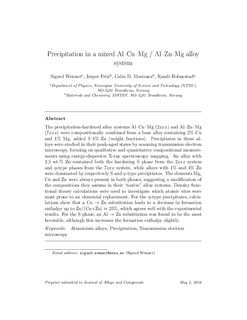| dc.contributor.author | Wenner, Sigurd | |
| dc.contributor.author | Friis, Jesper | |
| dc.contributor.author | Marioara, Calin Daniel | |
| dc.contributor.author | Holmestad, Randi | |
| dc.date.accessioned | 2017-11-06T13:10:49Z | |
| dc.date.available | 2017-11-06T13:10:49Z | |
| dc.date.created | 2016-05-27T11:10:18Z | |
| dc.date.issued | 2016 | |
| dc.identifier.citation | Journal of Alloys and Compounds. 2016, 684 195-200. | nb_NO |
| dc.identifier.issn | 0925-8388 | |
| dc.identifier.uri | http://hdl.handle.net/11250/2464280 | |
| dc.description.abstract | The precipitation-hardened alloy systems Al–Cu–Mg (2xxx) and Al–Zn–Mg (7xxx) were compositionally combined from a base alloy containing 2% Cu and 1% Mg, added 1–4% Zn (weight fractions). Precipitates in these alloys were studied in their peak-aged states by scanning transmission electron microscopy, focusing on qualitative and quantitative compositional measurements using energy-dispersive X-ray spectroscopy mapping. An alloy with 2.5 wt% Zn contained both the hardening S phase from the 2xxx system and η-type phases from the 7xxx system, while alloys with 1% and 4% Zn were dominated by respectively S and η-type precipitates. The elements Mg, Cu and Zn were always present in both phases, suggesting a modification of the compositions they assume in their “native” alloy systems. Density functional theory calculations were used to investigate which atomic sites were most prone to an elemental replacement. For the η-type precipitates, calculations show that a Cu → Zn substitution leads to a decrease in formation enthalpy up to Zn/(Cu + Zn) ≈ 25%, which agrees well with the experimental results. For the S phase, an Al → Zn substitution was found to be the most favorable, although this increases the formation enthalpy slightly. | nb_NO |
| dc.language.iso | eng | nb_NO |
| dc.publisher | Elsevier | nb_NO |
| dc.title | Precipitation in a mixed Al-Cu-Mg/Al-Zn-Mg alloy system | nb_NO |
| dc.type | Journal article | nb_NO |
| dc.description.version | submittedVersion | nb_NO |
| dc.source.pagenumber | 195-200 | nb_NO |
| dc.source.volume | 684 | nb_NO |
| dc.source.journal | Journal of Alloys and Compounds | nb_NO |
| dc.identifier.doi | 10.1016/j.jallcom.2016.05.132 | |
| dc.identifier.cristin | 1357927 | |
| dc.relation.project | Notur/NorStore: NN9158K | nb_NO |
| dc.relation.project | Notur/NorStore: NN6086K | nb_NO |
| dc.relation.project | Norges forskningsråd: 221714 | nb_NO |
| dc.description.localcode | This is a submitted manuscript of an article published by Elsevier Ltd in Journal of Alloys and Compounds, 17 May 2016 | nb_NO |
| cristin.unitcode | 194,66,20,0 | |
| cristin.unitname | Institutt for fysikk | |
| cristin.ispublished | true | |
| cristin.fulltext | preprint | |
| cristin.qualitycode | 1 | |
